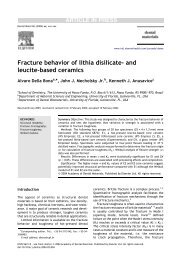Microleakage of various cementing agents for full cast crowns
Microleakage of various cementing agents for full cast crowns
Microleakage of various cementing agents for full cast crowns
You also want an ePaper? Increase the reach of your titles
YUMPU automatically turns print PDFs into web optimized ePapers that Google loves.
446<br />
related to pulpal problems [2,3], hypersensitivity,<br />
and secondary caries [4], the latter being the most<br />
common reason why restorations are replaced [5].<br />
Few studies have dealt with microleakage in <strong>full</strong><br />
<strong>cast</strong> <strong>crowns</strong> based on different types <strong>of</strong> <strong>cementing</strong><br />
<strong>agents</strong> [6–10]. Moreover, the methodologies and<br />
<strong>cementing</strong> <strong>agents</strong> used in these studies have been<br />
too diverse to allow direct comparison <strong>of</strong> the data.<br />
But it is possible to analyze different types <strong>of</strong><br />
commercially available <strong>cementing</strong> <strong>agents</strong> that can<br />
be used <strong>for</strong> long-term cementation <strong>of</strong> fixed restorations.<br />
These include zinc-phosphate cements,<br />
conventional glass–ionomer cements, resin-modified<br />
glass–ionomer cements, standard resin<br />
cements, and a recently developed material<br />
described as self-adhesive universal resin cement.<br />
The objective in developing this cement was to<br />
combine the ease <strong>of</strong> handling <strong>of</strong>fered by glass–<br />
ionomer cements with the favorable mechanical<br />
properties [11], attractive esthetics [12], and good<br />
adhesion <strong>of</strong> resin cements [13].<br />
A review <strong>of</strong> the literature by Raskin et al. [14]<br />
showed that 62.5% out <strong>of</strong> 144 studies on microleakage<br />
per<strong>for</strong>med between 1992 and 1998 evaluated<br />
microleakage in Class V cavities, while only<br />
4.3% evaluated microleakage and marginal gaps as<br />
study parameters involved in crown restorations.<br />
These latter include only a limited number <strong>of</strong><br />
studies [9,10] investigating the correlation between<br />
microleakage and marginal gaps in <strong>full</strong> <strong>cast</strong> <strong>crowns</strong>;<br />
no such correlation was found. However, the<br />
significance <strong>of</strong> the marginal gaps <strong>of</strong> <strong>full</strong> <strong>cast</strong><br />
restorations and their clinical consequences remain<br />
to be determined.<br />
The objective <strong>of</strong> the present in vitro study was to<br />
investigate microleakage and marginal gaps associated<br />
with <strong>cementing</strong> <strong>agents</strong> in <strong>full</strong> <strong>cast</strong> <strong>crowns</strong><br />
following artificial aging. Other questions to be<br />
examined were (1) whether <strong>various</strong> types <strong>of</strong><br />
<strong>cementing</strong> <strong>agents</strong> produce the same sealing ability<br />
<strong>for</strong> definite bonding <strong>of</strong> indirect restorations and (2)<br />
in how far microleakage results differ depending on<br />
whether the margins <strong>of</strong> the restoration are placed in<br />
dentin or in enamel. A final objective was to<br />
determine whether there was a connection between<br />
microleakage and marginal gaps in <strong>full</strong> <strong>cast</strong> <strong>crowns</strong>.<br />
Materials and Methods<br />
Specimen preparation<br />
A total <strong>of</strong> 60 freshly extracted non-carious permanent<br />
human molars with <strong>full</strong>y developed roots were<br />
selected <strong>for</strong> this study. All teeth were stored in<br />
A. Piwowarczyk et al.<br />
distilled water at room temperature immediately<br />
after extraction. Calculus and residual periodontal<br />
tissue were removed using a surgical knife, scaler,<br />
and curette. Subsequently, the teeth were conservatively<br />
polished using a rotating brush and<br />
pumice.<br />
The preparations <strong>for</strong> the <strong>full</strong> <strong>cast</strong> <strong>crowns</strong> were<br />
per<strong>for</strong>med using a suitable design and a converging<br />
angle <strong>of</strong> around 68 to achieve optimal retention and<br />
resistance properties. The occlusal and axial surfaces<br />
were reduced by approximately 1.2 and<br />
0.8 mm, respectively. The cervical preparation<br />
margins were designed as circular chamfers using<br />
torpedo-shaped diamond burs and water-cooling<br />
(Gebr. Brasseler, Lemgo, Germany; No. 878,314,<br />
size 012). The preparations were finished with the<br />
help <strong>of</strong> magnifying loupes (magnification !3.5;<br />
Zeiss, Oberkochen, Deutschland; serial #53-20)<br />
using fine and extra-fine diamond burs (Gebr.<br />
Brasseler, Lemgo, Germany; No. 8878.314 and<br />
878EF.314, size 012). Subsequently, a final check<br />
<strong>of</strong> the preparations was per<strong>for</strong>med. The mesial and<br />
distal margins were located in dentin, while the<br />
vestibular and palatal/lingual margins were located<br />
in enamel.<br />
For the model dies, impressions <strong>of</strong> the prepared<br />
teeth were taken with Impregum Penta (3M ESPE,<br />
Seefeld, Germany) and poured with Type IV resinstabilized<br />
extra-hard stone (esthetic-base 300;<br />
dentona AG, Dortmund, Germany; lot #51001742)<br />
following the manufacturer’s mixing instructions.<br />
The stone was allowed to set <strong>for</strong> 40 min and then<br />
removed from the impression. The resultant stone<br />
dies were trimmed and covered with stone hardener<br />
(Classic Hardener Spacer clear; Kerr Lab, Belle<br />
de St Claire, France) followed by two layers <strong>of</strong> die<br />
spacer (Classic Cement Spacer blue; Kerr Lab, Belle<br />
de St Claire, France) above the preparation margin.<br />
The preparation margin was marked with a nongraphite<br />
pencil under a stereomicroscope at !32<br />
magnification (Zeiss, Oberkochen, Germany; Stemi<br />
2000-C, serial #2004003753). Subsequently, red<br />
cervical wax and blue modeling wax (YETI Dentalprodukte,<br />
Engen, Germany) were used to model <strong>full</strong><br />
<strong>crowns</strong> <strong>of</strong> 0.5 mm thickness. Four round reference<br />
marks approximately 1.5 mm in diameter were<br />
applied in the mesial, distal, vestibular and<br />
lingual/palatal segments centrally around 3 mm<br />
above the preparations located in enamel and<br />
dentin. Five wax copings each were embedded in<br />
a #3 muffle ring with phosphate-bonded investment<br />
(Precibalite plus; Dentona AG, Dortmund,<br />
Germany; lot #0501101). After setting, the muffle<br />
was heated and a centifugal <strong>cast</strong>ing per<strong>for</strong>med<br />
using a Type IV high-gold <strong>cast</strong>ing alloy (Portadur P4;<br />
Wieland Edelmetalle GmbH, P<strong>for</strong>zheim, Germany;
















